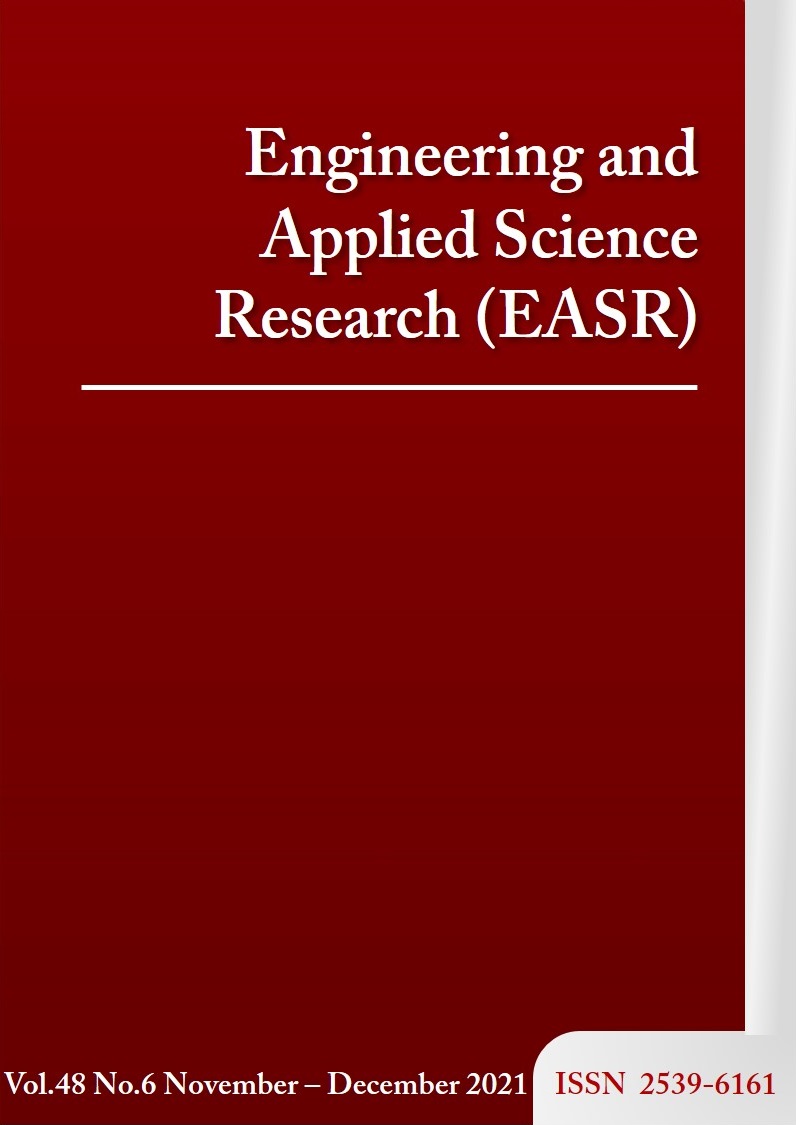Effect of insole-footwear combination on foot biomechanics: A finite element study
Main Article Content
Abstract
The aim of this study was to investigate the biomechanics of foot after wearing different footwear types incorporated with insole using Finite Element (FE) analysis. The studied models included barefoot, combination of insole and rigid footwear, combination of insole and elastic footwear without mid-foot cavity, and combination of insole and elastic footwear with mid-foot cavity. The results showed that insole and rigid footwear could reduce foot pressure, ankle joint pressure, and bone stress, but still not redistributing the foot pressure. The insole and elastic footwear without mid-foot cavity could significantly reduce forefoot pressure while the foot pressure was shifted toward mid-foot region instead. The insole and elastic footwear with mid-foot cavity could alleviate pressure in the mid-foot region better than footwear without mid-cavity.
Article Details
This work is licensed under a Creative Commons Attribution-NonCommercial-NoDerivatives 4.0 International License.
References
[2] Bus SA, Zwaferink JB, Dahmen R, Busch-Westbroek T. State of the art design protocol for custom made footwear for people with diabetes and peripheral neuropathy. Diabetes Metab Res Rev. 2020;36(Suppl 1):e3237.
[3] Hellstrand Tang U, Zugner R, Lisovskaja V, Karlsson J, Hagberg K, Tranberg R. Comparison of plantar pressure in three types of insole given to patients with diabetes at risk of developing foot ulcers - a two-year, randomized trial. J Clin Transl Endocrinol. 2014;1(4):121-32.
[4] Kang GE, Zahiri M, Lepow B, Saleem N, Najafi B. The effect of daily use of plantar mechanical stimulation through micro-mobile foot compression device installed in shoe insoles on vibration perception, gait, and balance in people with diabetic peripheral neuropathy. J Diabetes Sci Technol. 2019;13(5):847-56.
[5] Martinez-Santos A, Preece S, Nester CJ. Evaluation of orthotic insoles for people with diabetes who are at-risk of first ulceration. J Foot Ankle Res. 2019;12:35.
[6] Zwaferink JBJ, Custers W, Paardekooper I, Berendsen HA, Bus SA. Optimizing footwear for the diabetic foot: data-driven custom-made footwear concepts and their effect on pressure relief to prevent diabetic foot ulceration. PLoS One. 2020;15(4):e0224010.
[7] Hamatani M, Mori T, Oe M, Noguchi H, Takehara K, Amemiya A, et al. Factors associated with callus in patients with diabetes, focused on plantar shear stress during gait. J Diabetes Sci Technol. 2016;10(6):1353-9.
[8] Tang UH, Zugner R, Lisovskaja V, Karlsson J, Hagberg K, Tranberg R. Foot deformities, function in the lower extremities, and plantar pressure in patients with diabetes at high risk to develop foot ulcers. Diabet Foot Ankle. 2015;6:27593.
[9] Hähni M, Hirschmüller A, Baur H. The effect of foot orthoses with forefoot cushioning or metatarsal pad on forefoot peak plantar pressure in running. J Foot Ankle Res. 2016;9:44.
[10] Xu R, Wang Z, Ma T, Ren Z, Jin H. Effect of 3D printing individualized ankle-foot orthosis on plantar biomechanics and pain in patients with plantar fasciitis: a randomized controlled trial. Med Sci Monit. 2019;25:1392-400.
[11] Xu R, Wang Z, Ren Z, Ma T, Jia Z, Fang S, et al. Comparative study of the effects of customized 3D printed insole and prefabricated insole on plantar pressure and comfort in patients with symptomatic flatfoot. Med Sci Monit. 2019;25:3510-9.
[12] Chantarapanich N, Wongsiri S, Sitthiseripratip K. Influence of insole slope on bone joint stress, foot bone stress, and foot pressure distribution. Songklanakarin J Sci Technol. 2019;41(2):375-82.
[13] Liu X, Yue Y, Wu X, Hao Y, Lu Y, Pellicano F. Finite element analysis of shock absorption of porous soles established by grasshopper and UG secondary development. Math Probl Eng. 2020;2020:1-12.
[14] Luo G, Houston VL, Garbarini MA, Beattie AC, Thongpop C. Finite element analysis of heel pad with insoles. J Biomech. 2011;44(8):1559-65.
[15] Chantarapanich N, Nanakorn P, Chernchujit B, Sitthiseripratip K. A finite element study of stress distributions in normal and osteoarthritic knee joints. J Med Assoc Thai. 2009;92(Suppl 6):S97-103.
[16] MatWeb. DSM Biomedical Elasthane™ 55D Thermoplastic Polyether Polyurethane (TPU) [Internet]. Blacksburg: MatWeb; 2020. [cited 2020 Dec 12]. Available from: http://www.matweb.com/search/datasheettext.aspx?matguid=261c666d057741fe 896dbece622b8d42.
[17] Mei Q, Gu Y, Xiang L, Yu P, Gao Z, Shim V, et al. Foot shape and plantar pressure relationships in shod and barefoot populations. Biomech Model Mechanobiol. 2020;19(4):1211-24.
[18] Chantarapanich N, Siripanya A, Sucharitpwatskul S, Wanchat S. Validation of finite element model used to analyze sheet metal punching process in automotive part manufacturing. 7th International Conference on Key Engineering Materials (ICKEM 2017); 2017 Mar 11-13; Penang, Malaysia. Bristol: IOP Publishing Ltd; 2017. p. 1-5.
[19] Campanelli V, Fantini M, Faccioli N, Cangemi A, Pozzo A, Sbarbati A. Three-dimensional morphology of heel fat pad: an in vivo computed tomography study. J Anat. 2011;219(5):622-31.
[20] Telfer S, Erdemir A, Woodburn J, Cavanagh PR. What has finite element analysis taught us about diabetic foot disease and its management? a systematic review. PLoS One. 2014;9(10):e109994.
[21] Taylor D, Kuiper JH. The prediction of stress fractures using a ‘stressed volume’ concept. J Orthop Res. 2001;19(5):919-26.
[22] Reints R, Hijmans JM, Burgerhof JGM, Postema K, Verkerke GJ. Effects of flexible and rigid rocker profiles on in-shoe pressure. Gait Posture. 2017;58:287-93.
[23] Mazur F, Swoboda B, Carl HD, Lutter C, Engelhardt M, Hoppe MW, et al. Plantar pressure changes in hind foot relief devices of different designs. J Exp Orthop. 2019;6(1):7.
[24] Chantarapanich N, Puttawibul P, Sitthiseripratip K, Sucharitpwatskul S, Chantaweroad S. Study of the mechanical properties of photo-cured epoxy resin fabricated by stereolithography process. Songklanakarin J Sci Technol. 2013;35(1):91-8.



